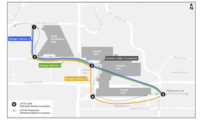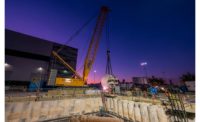Eighteen months after breaking ground, the new $52.5 million loop transit system at the Las Vegas Convention Center made its public debut on April 9. Built by Elon Musk’s underground construction start-up The Boring Co., the twin .8-mile tunnels initially will use chauffeured Tesla vehicles to help event visitors traverse the expansive 200-acre convention center campus, which is now adding another 1.4 million sq ft of exhibit space.
The Convention Center Loop is The Boring Co.’s first completed commercial project.
Begun in November 2019, it used a tunnel boring machine originally made by Canadian manufacturer Lovat Inc., that was previously used for other infrastructure projects, to build the tubes sequentially 40 ft below the surface. With an outer diameter of 13.5 ft and an inner diameter of 12 ft, each tunnel was bored in approximately four months.
The Boring Co. also built an underground station located midway between the system’s two above-ground stations, which are connected to the tunnels by ramps. To add a bit of Las Vegas glitz, the paved tunnels and underground station are also fitted with multi-colored LED lighting. A separate command center provides space for system monitoring.
According to the Las Vegas Convention and Visitors Authority, the system can accommodate up to 4,400 riders per hour. Plans call for an eventual switchover to autonomous Tesla vehicles.
Nearby the company is working with the City of Las Vegas to develop the Las Vegas Loop, a 15-mile point-to-point system to connect the Strip, McCarren International Airport and downtown. That project is expected to use the company’s custom-built Prufrock TBM, which it claims is designed to tunnel at a speed greater than 1 mile per week.
A Las Vegas Loop route map indicates that the Convention Center loop could eventually be integrated into the larger system.
No timeline has been announced for the Las Vegas Loop, estimated to cost between $75 million and $150 million. Under the agreement with the city, The Boring Co, will pay for tunnel construction, while hotels and other attractions along the route will pay to design and build stations.





Post a comment to this article
Report Abusive Comment